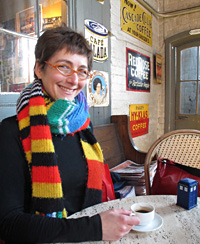I've been doing a lot of colourwork recently, and I love the speed I can get by stranding colours with two hands.
When I wrote that post, I mentioned Combination Knitting. I should explain myself, I figure.
It's pretty clear that Norwegian or not, the purl stitch can be cumbersome in Continental knitting.

Some knitters approach it another way - they just wrap the purl stitch the "easy" way.

This results in stitches that are oriented the "wrong" way on your needle. Normally, the right leg of the stitch is at the front of the needle. The result of an "incorrect" purl wrap is that the left leg of the stitch is at the front of the needle. You can see this on the following right side row...

If, on the following row, you were to knit this normally - through the front loop - the resulting stitch would be twisted. Twisted stitches are generally undesirable, as they look different, and they tend to tighten up your knitting. (There are times that twisted stitches are used for effect - often in a twisted ribbing, which is tidy and tight and has a terrific corded look.)
How to compensate for mis-oriented stitches? Knit them through the back loop!

Seriously! It's that easy!
That's Combination Knitting.
Now - some caveats. It's most appropriate for stocking stitch worked flat. For garter stitch, or stocking stitch in the round, you're only knitting, therefore only wrapping the usual way, so the stitches end up oriented the usual way and so you will need to work them the usual way.
In addition, when working Combination style, because your stitches are oriented the other way on the knit side, you need to compensate in your decreases: for a "normal" Western knitter, k2tog leans to the right, for a Combination knitter, k2tog leans to the left. In many situations this doesn't matter, but in applications like lace, it can make an unholy mess.
A skilled combination knitter knows that when there's a k2tog in the pattern, you need to work an ssk, and when there's an ssk called for, you need to work a k2tog.
The name refers to the fact that it's a combination of the standard Western way of knitting - the method that most Western Europeans and North Americans learn, and the Eastern Method, common in Far Eastern Europe and the Near/Middle East.
The goddess of Combination Knitting is Annie Modesitt. Learn more at her website.
When worked with the yarn in your left hand, Continental style, the Combination Method is screamingly fast. Annie tells a terrific story about a yarn shop owner accusing her of lying because of the speed with which she finished her first sweater project.
In fact, Ms. Modesitt offers a free online class in the technique - more info here.
Give it a go - you may surprise yourself!












